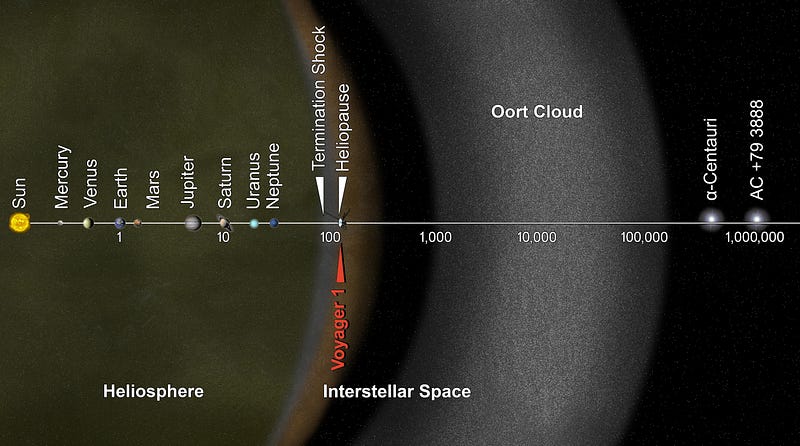The Enigmatic Oort Cloud: The Outer Limits of Our Solar System
Written on
Chapter 1: Understanding the Oort Cloud
How vast is our Solar System? It's incredibly extensive, especially when considering the Oort Cloud as part of it! This region, named after the Dutch astronomer Jan Oort (1900–92), who theorized in 1932 that a multitude of small celestial bodies exist at the farthest edge of our Solar System, serves as the origin point for long-period comets. These comets make such infrequent visits to the inner Solar System that many have only been recorded once throughout human history. Although many short-period comets likely originated from the Oort Cloud, they were drawn into smaller orbits due to the gravitational pull of the outer giant planets.
While direct observation of the Oort Cloud from Earth is impossible, and no spacecraft can reach it to send data back, the scientific community largely agrees on its existence and composition. It is estimated that the Oort Cloud harbors trillions of objects, primarily icy and rocky fragments no larger than a kilometer across. These remnants are believed to be leftover materials from the Sun's initial disc of planetary matter that never formed into planets, scattered to the Solar System's fringes by the gravitational forces of the outer planets, such as Jupiter and Saturn.
The term "cloud" aptly describes this region, as it does not consist of a disc of objects orbiting the Sun in a unified plane like the planets. Instead, it forms a spherical halo that radiates outward in all directions. Interestingly, scientists also propose the existence of an "inner Oort Cloud," which takes on a disc-like shape.
Section 1.1: The Extent of the Oort Cloud
There is ongoing discussion regarding the boundaries of the Oort Cloud. To simplify the understanding of distances within the Solar System, astronomers use the Astronomical Unit (AU), which represents the average distance from Earth to the Sun. One estimate suggests that the Oort Cloud begins at around 2,000 AUs and stretches out to 50,000 AUs. Conversely, some astronomers speculate that its outer edge could range from 100,000 AUs to 200,000 AUs.
For perspective, the farthest planet, Neptune, orbits at 37 AUs from the Sun, while the Kuiper Belt—which contains a mix of rocky debris and dwarf planets like Pluto—extends to about 50 AUs. If we accept the furthest boundary of the Oort Cloud, it translates to objects existing over three light-years away from the Sun. To put this in context, Proxima Centauri, the nearest star to our solar system, is located 4.25 light-years away. Notably, Proxima Centauri's mass is only about a tenth of the Sun's, which explains why the Oort Cloud's outermost objects remain bound to the Sun's gravitational influence.
Nonetheless, the Sun's gravitational pull diminishes significantly at such vast distances. Additionally, the rotation of the Milky Way exerts its own gravitational influence, bringing other stars closer over extensive time spans. These gravitational interactions can cause smaller bodies to break free from their ancient orbits and head towards the inner Solar System as comets.
Discover the Oort Cloud's significance and its role in the Solar System in this insightful video.
Section 1.2: The Vastness of Space
In light of our discussion regarding the Solar System, it's worth recalling Douglas Adams' famous observation from "The Hitchhiker’s Guide to the Galaxy":
“Space is big. Really big. You just won’t believe how vastly, hugely, mind-bogglingly big it is. I mean, you may think it’s a long way down the road to the chemist, but that’s just peanuts to space.”
Chapter 2: Exploring the Oort Cloud Further
This video dives deeper into the mysteries of the Oort Cloud, shedding light on its formation and significance.
